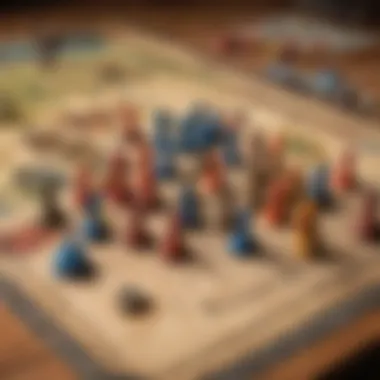Exciting Games for Large Groups: Indoor Fun and Engagement


Creative Activities
When organizing games for a large group indoors, creativity is key. Craft Ideas are an excellent way to engage children while fostering their artistic skills. Encouraging kids to share their imaginative side by creating unique craft pieces can be both entertaining and educational. Providing Step-by-Step Guides for each activity ensures that participants can follow along easily and feel accomplished upon completing their creations. The Educational Value of these activities lies in enhancing fine motor skills, creativity, and patience.
Fun Quizzes
Incorporating Fun Quizzes into indoor group gatherings adds an element of excitement and friendly competition. Quiz Topics can range from general knowledge to specific subjects depending on the audience's interests. Explaining different Question Types such as multiple-choice, true or false, and open-ended questions keeps participants engaged and challenges their thinking skills. The quizzes' Knowledge Reinforcement aspect helps solidify learned information in a fun and interactive manner.
Fact-Based Articles
Delving into Fact-Based Articles during indoor gatherings can be both enlightening and entertaining. Covering a variety of Topics caters to different interests within the group and sparks intriguing discussions. Presenting Engaging Content in a simple and digestible format captivates readers, making learning more enjoyable. Offering Additional Resources like related articles or external links provides an avenue for further exploration and learning beyond the gathering.
Icebreaker Games
In the realm of social gatherings, Icebreaker Games serve as the cornerstone of fostering connections and initiating interactions among participants. These games play a vital role in setting the tone for the event, breaking down barriers, and creating a harmonious atmosphere. They provide a platform for individuals to step out of their comfort zones, encouraging them to engage with others in a lighthearted and enjoyable manner. Icebreaker Games hold immense significance in this article as they lay the foundation for building camaraderie and sparking conversations, thus enhancing the overall experience for large groups gathered indoors.
Human Knot
Setting Up the Game
Setting up the Human Knot game involves participants standing in a circle and reaching their hands into the center, interlocking with others' hands to create a tangled knot. The challenge begins as they must navigate through the knot without releasing their grips, requiring communication, teamwork, and problem-solving skills. This setup brings about a sense of physical proximity and interdependence among players, making it an ideal icebreaker choice for encouraging collaboration and mutual understanding within the group.
Rules and Objectives
The Human Knot game operates on the simple rule of untangling the human knot without detaching hands. The primary objective is for participants to strategize and maneuver through the entanglement by twisting, bending, and stretching their bodies in unison. This rule cultivates cooperative efforts while fostering patience and effective communication, enabling individuals to work together towards a shared goal. The game's interactive nature promotes bonding and empathy, making it a popular and beneficial icebreaker activity for the article's context.
Strategy and Communication
Strategy and communication are paramount in successfully unraveling the Human Knot. Participants must coordinate movements, exchange ideas, and listen attentively to one another to navigate through the knots efficiently. Effective communication ensures smooth coordination, while strategic planning allows for the delegation of roles based on each individual's position within the entanglement. The game cultivates problem-solving skills and enhances interpersonal communication, offering a unique way to encourage teamwork and collaboration among participants in the indoor setting.
Two Truths and a Lie
Game Instructions
Two Truths and a Lie revolves around players sharing two true statements and one false statement about themselves. The rest of the group then tries to decipher which statement is the lie. This setup encourages participants to reveal interesting facts about themselves while challenging others to differentiate between truth and deception. Game Instructions are pivotal as they establish the framework for engaging conversations and promote a deeper understanding of one another's experiences.
Goal of the Game
The primary goal of Two Truths and a Lie is to test the ability of players to discern truths from falsehoods while learning more about their peers. By unraveling mysteries and uncovering hidden truths, participants engage in a thought-provoking exercise that encourages critical thinking and observation. The game aims to create an atmosphere of intrigue, curiosity, and mutual discovery, making it a favorable choice for stimulating interactions and fostering connections within a large group.


Tips for Success
Success in Two Truths and a Lie lies in crafting statements that blur the lines between reality and fiction, challenging others' perceptions and powers of deduction. Players can enhance their chances of tricking their counterparts by incorporating elements of truth in their false statements, adding layers of complexity to the guessing process. Moreover, active listening and astute observation play crucial roles in deciphering the truths and lies shared by others, offering valuable insights into their personalities and backgrounds. These tips foster a competitive yet genial environment, enhancing the game's entertainment value and fostering a playful spirit among participants.
Pictionary
Materials Needed
To engage in a riveting game of Pictionary, participants require pen and paper or a drawing board, category cards with different words or phrases, and a timer. The materials needed are minimal yet essential for the smooth execution of the game, allowing players to express their creativity and interpretation skills through drawing. The simplicity of the required materials makes Pictionary a convenient and accessible choice for energizing indoor group activities.
Gameplay Rules
The gameplay in Pictionary involves one player selecting a word or phrase from the category card and then attempting to depict it through a drawing, while team members guess the answer within a time limit. The rules emphasize quick thinking, artistic abilities, and effective communication between the drawing player and the guessers. By adhering to the gameplay rules, participants can experience an immersive and interactive challenge that tests their visual communication skills and creativity, adding a layer of excitement to the indoor gaming experience.
Variations and Adaptations
Pictionary offers a myriad of variations and adaptations to cater to different group dynamics and preferences. From introducing custom categories to incorporating charades elements or playing in teams to hosting tournaments, the game provides flexibility and room for customization based on participants' preferences. These variations bring diversity and creativity to the gameplay, allowing for a dynamic and engaging experience that transcends the conventional boundaries of a standard game of Pictionary. Embracing these adaptations encourages innovation and fosters a sense of inclusivity and enjoyment among players within the indoor setting.
Strategic Games
Strategic games play a pivotal role in this insightful article, offering a set of mental challenges that require critical thinking and planning. The significance of strategic games lies in their ability to enhance cognitive abilities and decision-making skills, providing a unique platform for participants to strategize and collaborate effectively. By delving into strategic games, individuals can hone their problem-solving capabilities and adaptability in dynamic situations, creating an enriching and intellectually stimulating environment that encourages teamwork and creativity. Through exploring strategic games, players can delve into a realm of complex scenarios that test their strategic acumen and foresight, fostering a sense of accomplishment and camaraderie among participants, making strategic games a cornerstone of this engaging article.
Escape Room Challenge
Setting the Scene
Embarking on the journey of the escape room challenge, the element of 'Setting the Scene' plays a fundamental role in immersing participants into the overarching narrative. This crucial aspect sets the mood, theme, and context of the gameplay, elevating the overall experience for all involved. By meticulously crafting the setting, organizers can transport players into a world full of mystery and intrigue, enhancing their engagement and investment in the challenge. The unique feature of 'Setting the Scene' lies in its ability to create a realistic and immersive environment that captivates participants, promoting a sense of excitement and curiosity throughout the gameplay. While 'Setting the Scene' demands careful planning and execution, its transformative impact on the escape room challenge makes it a popular and effective choice for this article, enriching the gaming experience for a large group indoors.
Time Limit and Clues
Within the realms of the escape room challenge, the element of 'Time Limit and Clues' serves as a critical driving force that adds intensity and urgency to the gameplay. The inclusion of a time limit creates a sense of thrill and pressure, urging participants to act swiftly and decisively in solving the puzzles within the designated timeframe. Moreover, strategically placed clues offer guidance and hints to aid players in unraveling the mysteries presented, fostering a cohesive and collaborative approach to problem-solving. The unique feature of 'Time Limit and Clues' lies in their ability to challenge participants' ability to think under duress while promoting effective communication and teamwork in a high-stakes environment. While the inclusion of a time limit can heighten the adrenaline-fueled experience, it also adds a layer of stress that may impact players differently, making it essential to balance the game dynamics for optimal enjoyment.
Team Collaboration
Central to the success of the escape room challenge is the aspect of 'Team Collaboration,' emphasizing the importance of communication, trust, and synergy among participants. This integrative element encourages individuals to leverage their diverse strengths and skills to overcome obstacles collectively, highlighting the power of synergy in achieving common goals. The key characteristic of 'Team Collaboration' lies in its ability to foster cohesive teamwork, where each member contributes uniquely to the group's progress, reinforcing interdependence and mutual support. The unique feature of 'Team Collaboration' lies in its capacity to cultivate leadership skills, conflict resolution, and effective decision-making among players, promoting a sense of unity and accomplishment upon successfully completing the challenge. While 'Team Collaboration' enriches the gaming experience by promoting social interaction and cooperation, it also presents challenges in managing different personalities and perspectives within the team, underscoring the importance of effective communication and cohesion for a gratifying gameplay experience.
Mafia
Roles and Gameplay


Delving into the intricate world of Mafia, the element of 'Roles and Gameplay' forms the foundation of this thrilling game, dictating the dynamics and strategies employed by participants. The key characteristic of this aspect lies in its division of players into unique roles, each with specific abilities and objectives, adding layers of complexity and intrigue to the gameplay. By assuming different roles, individuals engage in deductive reasoning, deception, and persuasion, crafting a narrative fraught with suspense and strategy. The interactive nature of 'Roles and Gameplay' challenges players to navigate alliances, betrayers, and accusations, testing their perceptiveness and teamwork in an environment rife with secrecy and mistrust. The uniqueness of 'Roles and Gameplay' lies in its capacity to immerse players in a world of intrigue and suspicion, where every decision carries weight and consequence, shaping the outcome of the game and fostering strategic thinking and adaptability among participants.
Winning Strategies
In the realm of Mafia, the pursuit of victory hinges on the mastery of 'Winning Strategies,' requiring players to employ cunning, foresight, and diplomacy to outmaneuver their opponents and achieve their objectives. The key characteristic of 'Winning Strategies' lies in the ability to anticipate, bluff, and manipulate information to sway the course of the game in one's favor, underscoring the importance of psychological acuity and strategic planning. By devising and executing optimal strategies, players can navigate the intricate web of alliances and betrayals inherent in Mafia, maximizing their chances of success while unraveling the mysteries veiled within the gameplay. The unique feature of 'Winning Strategies' lies in its dynamic and adaptive nature, where players must constantly evolve their tactics to outwit adversaries and secure their position, creating a thrilling and intellectually stimulating experience that challenges participants' strategic prowess and social finesse.
Debriefing Session
Upon the culmination of a riveting round of Mafia, the 'Debriefing Session' offers a moment of reflection and discussion where players can debrief on their experiences, strategies, and outcomes. This integral aspect provides a platform for players to share insights, perspectives, and feedback, fostering a collective understanding of the game's dynamics and interactions. The key characteristic of 'Debriefing Session' lies in its role in consolidating learning points, celebrating successes, and identifying areas for improvement or adjustment in future gameplay. Encouraging open dialogue and analysis, the 'Debriefing Session' enables players to reflect on their decisions, assess their performance, and learn from their experiences, promoting growth and development in strategic thinking and interpersonal skills. While 'Debriefing Session' enriches the post-game experience by promoting self-awareness and constructive feedback, it also requires facilitation and moderation to ensure a productive and respectful discourse among participants, underscoring the importance of reflection and collaboration in maximizing the learning potential of each Mafia session.
Interactive Team Activities
Interactive Team Activities play a crucial role in fostering collaboration and teamwork within a large group indoors. These activities not only encourage interaction but also enhance communication skills and promote mutual understanding among participants. By engaging in activities like Treasure Hunt, Charades, and Minute to Win It, individuals can develop valuable skills such as problem-solving, creativity, and strategic thinking. The collaborative nature of these games allows players to work together towards a common goal, creating a sense of camaraderie and cohesion within the group.
Treasure Hunt
Planning the Hunt
Planning the Hunt is a fundamental aspect of organizing a successful and enjoyable Treasure Hunt. This phase involves developing clues, choosing hiding spots, and setting the game's overall structure. Effective planning ensures that the hunt is challenging yet achievable, keeping participants engaged and motivated throughout. By strategically placing clues and hiding objects in clever locations, organizers can create an immersive and exciting experience for everyone involved.
Clues and Hidden Objects
Clues and Hidden Objects are essential elements that contribute to the intrigue and excitement of a Treasure Hunt. The quality of clues and the creativity used to hide objects significantly impact the overall enjoyment of the game. Well-thought-out clues challenge participants' problem-solving skills and encourage them to think outside the box. The strategic placement of hidden objects adds an element of surprise and adventure, keeping players on their toes and eager to uncover the next clue.
Team Coordination
Team Coordination is key to the success of a Treasure Hunt, emphasizing the importance of effective communication and collaboration among team members. Clear delegation of tasks, sharing of information, and synchronized efforts are vital for teams to work together harmoniously and solve clues efficiently. By fostering teamwork and coordination, this aspect of the game promotes mutual support and unity within the group, leading to a more rewarding and fulfilling experience.
Charades
How to Play
Understanding how to play Charades is essential for successfully conveying and guessing various concepts without using verbal communication. Players take turns acting out specific words or phrases while their team members attempt to decipher the message. This classic, yet engaging game encourages creativity, non-verbal expression, and quick thinking, making it a popular choice for group entertainment.
Acting Out Clues
Acting Out Clues involves using body language and gestures to represent words or phrases without speaking. This aspect of Charades tests players' ability to convey complex ideas through subtle movements and expressions. By honing their communication skills and adaptability, participants can enhance their non-verbal communication abilities and strengthen their bond as a team.
Guessing and Winners


The Guessing and Winners component of Charades adds an element of competition and excitement to the game. Successfully guessing clues within a time limit or accumulating points for correct answers can lead to team victory and individual recognition. This aspect of the game motivates players to be attentive, strategic, and cooperative, highlighting the value of effective teamwork and insightful guessing.
Minute to Win It
Game Set-up
Setting up Minute to Win It games involves preparing various challenges and organizing them into a series of timed activities. Each challenge is designed to test participants' speed, precision, and coordination within a minute or less. The dynamic nature of these games fosters a sense of urgency and excitement, challenging players to perform tasks quickly and accurately to achieve victory.
Challenges and Timer
The Challenges and Timer aspect of Minute to Win It games determine the difficulty level and pacing of the activities. From stacking cups to balancing objects, each challenge presents a unique test of skill and dexterity. The ticking timer adds an element of pressure, requiring participants to stay focused and composed under time constraints, enhancing the competitive and exhilarating nature of the game.
Celebrating Victories
Celebrating Victories at the conclusion of Minute to Win It games is an opportunity to recognize and appreciate participants' efforts and achievements. Whether through small rewards, acknowledgments, or simply cheering for each other, celebrating victories boosts morale and fosters a sense of accomplishment. This aspect of the game reinforces the importance of enthusiasm, sportsmanship, and shared joy in both winning and losing scenarios.
Brain Teasers and Trivia
Quiz Night
Topic Selection
When discussing the pivotal aspect of Topic Selection in Quiz Night, it becomes evident that the choice of topics plays a crucial role in the overall success of the event. Selecting diverse and intriguing topics ensures that participants remain engaged and motivated throughout the quiz. The key characteristic of Topic Selection lies in its ability to cater to the varied interests and knowledge levels of the audience, making it a popular and beneficial choice for creating a dynamic quiz experience. By offering a wide range of topics, hosts can attract a larger audience and enhance the overall appeal of the event. However, a potential disadvantage of Topic Selection is the challenge of balancing familiar topics with more challenging or niche subjects, which may impact participant satisfaction.
Question Format
The Question Format employed in Quiz Night contributes significantly to the overall entertainment value and educational benefits of the event. A well-crafted question format should be clear, concise, and engaging, ensuring that participants can easily comprehend and respond to the questions presented. The key characteristic of Question Format is its ability to test various cognitive skills such as memory, reasoning, and problem-solving, making it a popular choice for enhancing mental acuity during the quiz. Additionally, the unique feature of incorporating different question styles and difficulty levels adds depth to the quiz experience, providing both entertainment and intellectual stimulation. However, a potential disadvantage of complex question formats may be a decrease in participant engagement or understanding.
Scoring System
The Scoring System implemented in Quiz Night plays a crucial role in incentivizing participation and determining the overall winner. A well-designed scoring system should be transparent, fair, and motivating, encouraging healthy competition among participants. The key characteristic of the Scoring System lies in its ability to provide instant feedback and recognition for individual or team achievements, enhancing the competitive spirit of the event. By incorporating bonus points, time limits, or team challenges, hosts can create a dynamic scoring system that keeps participants actively involved and invested in the quiz. However, a potential disadvantage of complex scoring systems may lead to confusion or disputes among participants, affecting the overall experience.
Memory Game
Game Rules
Discussing the Game Rules of the Memory Game reveals the essential role they play in maintaining structure and fairness throughout the gameplay. Clearly defined game rules help establish boundaries, ensure equal opportunity for all participants, and enhance the overall gaming experience. The key characteristic of Game Rules is their ability to create a level playing field where players can compete or collaborate within a set framework, making it a popular and beneficial choice for fostering teamwork and cognitive skills. However, meticulous attention to detail and clarity is crucial to avoid misunderstandings or disputes during the game.
Increasing Difficulty
When exploring the concept of Increasing Difficulty in the Memory Game, it is evident that gradual skill challenges contribute to sustained engagement and skill development among players. Introducing incremental difficulty levels ensures that players are continuously challenged and motivated to improve their memory retention and recall abilities. The key characteristic of Increasing Difficulty lies in its capacity to adapt to players' skill levels, providing a customized experience that caters to both beginners and experienced participants. By incrementally increasing the complexity of memory tasks, hosts can create a challenging yet rewarding gaming environment that promotes growth and skill enhancement. However, a potential disadvantage of steep difficulty increments may lead to frustration or disinterest among players, underscoring the importance of a balanced and gradual progression.
Training Memory Skills
Delving into the realm of Training Memory Skills within the Memory Game, it becomes clear that these activities offer a valuable opportunity for cognitive enhancement and skill development. Structured memory training exercises help boost cognitive function, enhance concentration, and improve memory recall efficiency among participants. The key characteristic of Training Memory Skills is their ability to provide a systematic approach to enhancing specific cognitive functions, making it a popular choice for individuals seeking to boost their memory retention and recall abilities. By incorporating memory training exercises into the gameplay, hosts can create a stimulating and educational experience that benefits participants of all ages. However, potential disadvantages of intensive memory training may include mental fatigue or performance pressure, necessitating breaks and adaptive training strategies for optimal results.







